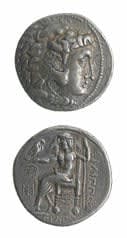Celtic Silver Tetradrachm Imitative of Phillip III, 3 Century BCE
Silver
C.2339
Obverse: Head of Herakles Wearing the Skin of the Nimean Lio Reverse: Zeus Enthroned Holding an Eagle and a Scepte When we speak today of 'Celts', we mean people who...
Obverse: Head of Herakles Wearing the Skin of the Nimean Lio
Reverse: Zeus Enthroned Holding an Eagle and a Scepte
When we speak today of 'Celts', we mean people who live on the very western edges of Europe, in Ireland, Wales, Cornwall, Scotland and Brittany. The word comes from Keltoi, the name which the Greek authors of the 5th century B.C. and later gave the native people of Western Europe from Spain to Czechoslovakia. The Celts also spread into Britain, Northern Italy, Germany, and parts of Asian Turkey. They were known to the Romans as the Gauls, but would have thought of themselves not as one people, but as different tribes. Celtic tribes at different times were Rome's enemies, allies and, once conquered, the soldiers, farmers and craftsmen of much of its empire. This coin is among the first ever minted in the Danube region and is highly influenced by the coinage of King Phillip III Arrhidaeus.
How many hands have touched a coin in your pocket or your purse? What eras and lands have the coin traversed on its journey into our possession? As we reach into our pockets to pull out some change, we rarely hesitate to think of who touched the coin before us, or where the coin will venture to after us. More than money, coins are a symbol of the state that struck them, of a specific time and place, whether currency in the age we live or an artifact of a long forgotten empire. This stunning hand-struck coin reveals an expertise of craftsmanship and intricate sculptural detail that is often lacking in contemporary machine-made currencies. This coin is more than an artifact; it is a memorial to a lost culture passed from the hands of civilization to civilization, from generation to generation.
Reverse: Zeus Enthroned Holding an Eagle and a Scepte
When we speak today of 'Celts', we mean people who live on the very western edges of Europe, in Ireland, Wales, Cornwall, Scotland and Brittany. The word comes from Keltoi, the name which the Greek authors of the 5th century B.C. and later gave the native people of Western Europe from Spain to Czechoslovakia. The Celts also spread into Britain, Northern Italy, Germany, and parts of Asian Turkey. They were known to the Romans as the Gauls, but would have thought of themselves not as one people, but as different tribes. Celtic tribes at different times were Rome's enemies, allies and, once conquered, the soldiers, farmers and craftsmen of much of its empire. This coin is among the first ever minted in the Danube region and is highly influenced by the coinage of King Phillip III Arrhidaeus.
How many hands have touched a coin in your pocket or your purse? What eras and lands have the coin traversed on its journey into our possession? As we reach into our pockets to pull out some change, we rarely hesitate to think of who touched the coin before us, or where the coin will venture to after us. More than money, coins are a symbol of the state that struck them, of a specific time and place, whether currency in the age we live or an artifact of a long forgotten empire. This stunning hand-struck coin reveals an expertise of craftsmanship and intricate sculptural detail that is often lacking in contemporary machine-made currencies. This coin is more than an artifact; it is a memorial to a lost culture passed from the hands of civilization to civilization, from generation to generation.



